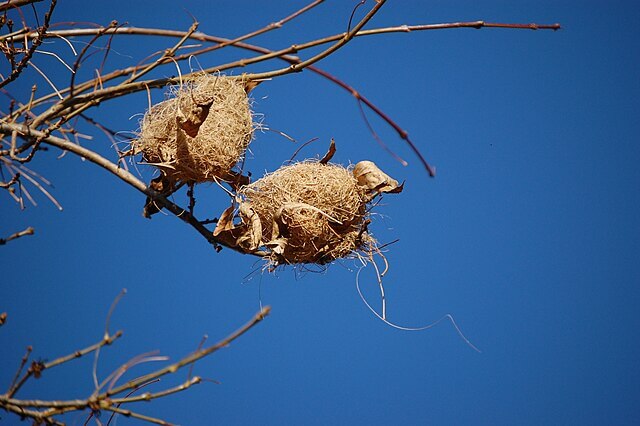Oriole Nests: Relics of Summer
By Joyce Bateman
Broadcast 2.28 & 3.2.2024

Bullock’s Oriole nests. Photo by Eugene Zelenko, CC-by-SA 4.0.
Listen:
Mid-March brought another dull gray sky to the Helena Valley of Montana. The leaden clouds threatened a snow squall, the latest in a succession of storms. My birder friend and I were eager yet downhearted. When would the spring bird migration bring us the song and color we longed for? Despite the weather, we spontaneously decided to look for any signs of spring. We chose Spring Meadow Lake, a local birder’s haunt that promised easy access and hopefully not too much snow, ice or mud.
We essentially had the place to ourselves as we searched not only for signs of bird life but also for that harbinger of spring in riparian areas—pussy willows. We searched slowly yet eagerly, closely examining the strong wands of various willows. Our hopeful attitude became more subdued when we discovered no sign of catkins. However, our hopes of spring were still tenuously alive, so we pressed on.
As we continued our botanical survey, we both noted some curious objects suspended high in the cottonwoods. They looked like bulging stockings decorating a mantle at Christmastime. They were certainly gifts of a sort for our winter-weary senses. These were the unique nests of Bullock’s Orioles. Those striking yellow and black avian friends had not yet returned to our chilly northwestern state—they knew better. However, the relics of their previous year’s handiwork remained, still swaying in the breeze that now carried a few snowflakes.
How did these seemingly delicate pouches survive the blizzards of last winter? Orioles must know what materials are strongest. These nests were still securely attached to solid branches, further proving that orioles are small feathered engineers. Orioles use their beaks to weave these sturdy works of art with a technique much like knitting a sock. Bullock’s Oriole nests are typically about four inches deep and four inches across, with a small opening in the top about two to three inches wide. However, the nest size among oriole species is varied. The deepest oriole nests are those of the Altamira Oriole, found in extreme south Texas and Central America. Their spectacular pendulous nests dangle down more than two feet.
Since orioles are tolerant of human activity, nest materials often include cast-off twine or other synthetic fibers in addition to natural plant material such as grasses, weeds and animal hair. It makes sense that orioles commonly nest near water, since willow catkins and fluffy cottonwood seed clusters work perfectly to make a cozy interior for up to seven eggs, and eventually the hatchlings.
The intricate nest-building process takes from one to two weeks, depending on the weather. Even in the avian realm, wind and rain can slow down construction projects. The timeframe also depends on whether the birds are seasoned nest builders or newbies. Although nest building is an instinct, more experienced orioles produce neater and sturdier nests. Even though the nests are sturdy, orioles do not typically reuse the nests from the previous season. However, occasionally, they will rework a previous season’s efforts.
As we continued our exploration, we examined the upper story of the deciduous trees more carefully. Our eyes picked out several more nests dangling in the same area. Orioles seem to tolerate neighbors of their own kind as well as humankind. These marvelous little pouches suspended from the ends of flexible tree branches may seem precarious, but this keeps them safe from predators.
My friend and I reflected on the early spring perspective of the bare deciduous canopy which readily revealed evidence of last summer’s bird activity. We knew this habitat would soon be full of green and once again bustling with nest builders. For now, we were content that we had braved a chilly day, overcoming our weariness of a lingering winter to venture out. The telltale evidence of bird life we stumbled upon buoyed our spirits. We may not have found much in the way of feathers, but our minds were fluttering, full of optimism for the approaching spring and the hope of finding much less snow and ice at our feet.
Every week since 1991, Field Notes has inquired about Montana’s natural history. Field Notes are written by naturalists, students, and listeners about the puzzle-tree bark, eagle talons, woolly aphids, and giant puffballs of Western, Central and Southwestern Montana and aired weekly on Montana Public Radio.
Click here to read and listen to more Field Notes. Field Notes is available as a podcast! Subscribe on Apple Podcasts or wherever you listen to podcasts.
Interested in writing a Field Note? Contact Allison De Jong, Field Notes editor, at adejong [at] montananaturalist [dot] org or 406.327.0405.
Want to learn more about our programs as well as fun natural history facts and seasonal phenology? Sign up for our e-newsletter! You can also become a member and get discounts on our programs as well as free reciprocal admission to 300+ science centers in North America!












